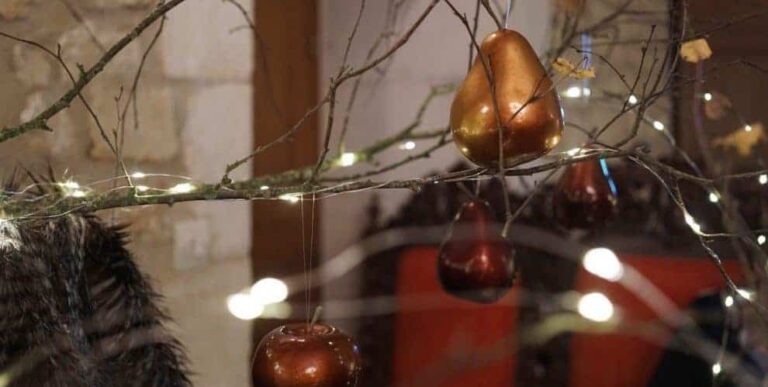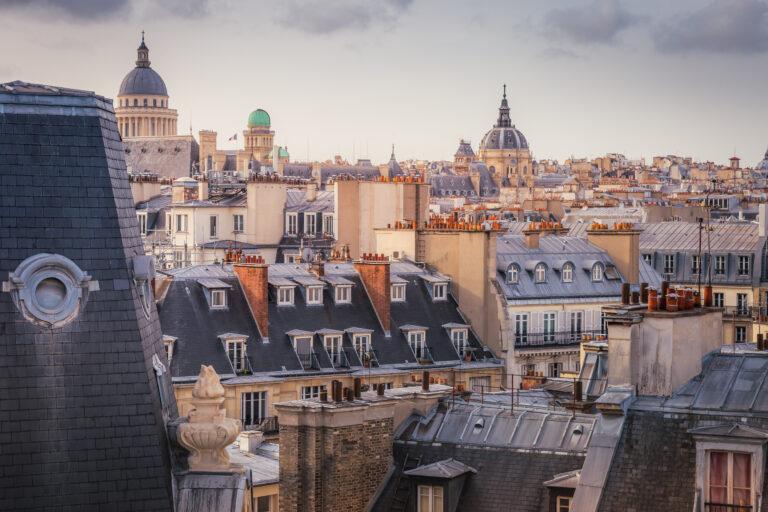Visiting Rocamadour – France’s Hilltop Sanctuary
Rocamadour rises from the Alzou Valley like an elaborate movie set – etched into a limestone cliff, surrounded by the lush forests of Parc Naturel Regional des Causses du Quercy, winding rivers and prehistoric caves, it’s little wonder it belongs to the “Les Plus Beaux Villages de France” (most beautiful villages in France) club.
The enchanting village is a highlight of the Lot Valley region and a known pilgrimage site on the Way of St. James.
Narrow cobbled streets of the lower village are lined with charming artisan shops, delicatessens and terraced restaurants, while on the upper levels, atmospheric chapels and monastic complexes beckon pilgrims to pay homage to the Black Madonna – a statue said to perform miracles…
Perched on the clifftop overlooking the valley, you can walk the castle ramparts, photograph the breathtaking scenery, or hike to the nearby prehistoric grottos to see 20,000-year-old cave drawings.


Rocamadour has long been on our wishlist of places to visit in France, so during a recent stay in Cantal, we took a day trip to the hilltop village to experience it for ourselves! Read on for suggestions about what to see in Rocamadour and its surroundings.
A Brief History of Rocamadour
Rocamadour’s history spans centuries, with evidence of people living here as far back as the Paleolithic era. A group of settlers from Germany arrived around the 8th century B.C., but it was a little later that the greatest changes took place.

Legend states, that in the 1100s, a miracle occurred in the village when a well-preserved body was discovered and excavated. The local people deduced that this body belonged to a saint with connections to Jesus – a man who became known as St. Amadour. To add credence to this story, a carved statue of the Black Madonna (also known as the Black Virgin) was found alongside him in his tomb.
Word spread of the discovery and Benedictine monks began to record miracles that would occur in the village. Such miracles saw pilgrims flock to Rocamadour in droves, and many left sizeable donations.
Over the years that followed, chapels, abbeys and sanctuaries were constructed, and Rocamadour became a prominent site of pilgrimage in Europe. The influential village became popular with nobility and the clergy, with the pope’s representatives retreating here during the Albigensian Crusades.

However, not everyone was happy about what the village had come to represent. During the Wars of Religion, Protestant mercenaries destroyed the religious relics, buildings – and the body of Saint Amadour, and later, during the French Revolution, the sites were looted again.
Today, Rocamadour still attracts pilgrims, but it also appeals to outdoor adventurers, foodies, photographers and historians, all eager to uncover further mysteries.
Getting to Rocamadour
There are several main driving routes leading to Rocamadour. You can travel from Brive-la-Gaillarde and Montauban along the A20, and from Figeac and Martel on the D840. These roads both offer easy access to the parking zones on the edge of the village.
These parking zones are clearly marked and easy to find. Parking P5 is at the bottom of the valley and offers the possibility of taking the little tourist train up to the village. Whereas the P1 parking lot offers a scenic walk along the top ridge of the valley.

Rocamadour also has access to a train station that it shares with Padirac. For obvious reasons (Rocamadour is etched into a cliff), the station isn’t in the town itself, but four kilometres away to the northeast. A handful of trains depart from Brive and Figeac daily, and there’s one direct train from Paris, but a taxi will be required to get from the station to Rocamadour Centre.
You can also catch direct buses to Rocamadour from Souillac (877), Figeac and Gramat (876), although they only run a few times each day.

If you’re planning to stay in the Lot Valley or the neighbouring Dordogne on holiday, you might find it more convenient to book a half or full-day guided tour to Rocamadour from Sarlat-la-Caneda.
Best Things to do in Rocamadour
Spending one day in Rocamadour is enough to do & see most of the things on this list. But if you want to experience some of the longer walks, or day trips, plan at least 3-4 days in the area to take it all in.
Wander through the Medieval Village

As you walk through Rocamadour’s medieval village, it feels a bit like stepping back in time. The village is on more than one level, but most visitors begin their journey in the lower section around Rue de la Couronnerie, accessed via stone gateways from the parking zones.


Along the narrow main street, the architecture appears to have changed little since the Middle Ages. Beautiful stone houses with wooden shutters and arched doorways are adorned with plants and intermittently clad in vines.


Many of the shops here cater to tourists, selling rosary beads and religious figurines, but the town also has some amazing artisan galleries, boutique shops and delicatessens.
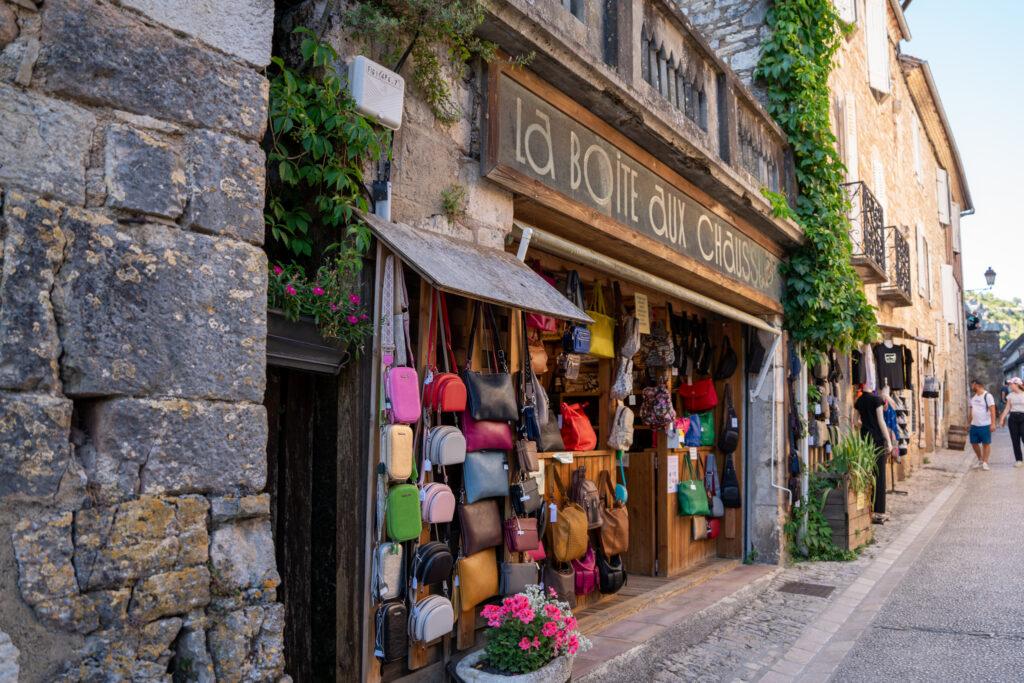
Pretty tree-lined terraces and courtyards invite you to sip coffee and admire the outstanding views above and below.
Quaint brasseries serve flavourful Lot Valley specialities, while boutique hotels offer reasonably priced rooms for overnight stays. When you’ve fully explored the lower town, head for the Grand Staircase to access the most important religious sites of Rocamadour.
Climb the Grand Escalier


The Grand Escalier or Grand Staircase is accessed from Rue de la Couronnerie. The steep 216 steps lead to many of the eight major religious sites of Rocamadour.
It is said, that in years gone by, pilgrims once ascended these stairs on their knees as an act of penance, and even today, some visitors still favour this ancient tradition. However, if you wish to try it yourself, it’s better to do this early in the day before the staircase gets too busy. As you climb the stairs, you’ll be met with outstanding views of the Alzou Valley and gorge.
Families travelling with young kids or visitors with limited mobility don’t have to miss out on the iconic monuments either. These days there’s also a lift/elevator to transport you from the lower level to the sanctuaries of the upper village.
Visit the Basilica of St-Saveur
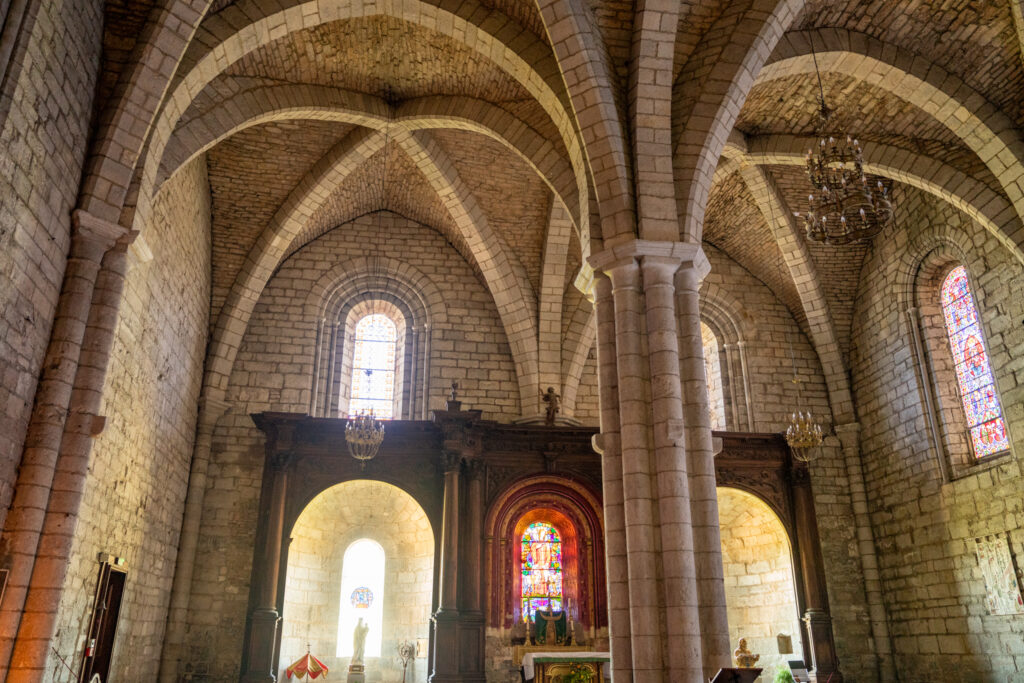
When you finally reach the top of the Grand Escalier, you’ll notice a cluster of buildings that make up the religious sanctuary. One of the most striking is the Basilica of Saint-Saveur built into the cliff face.
During medieval times, around the 12th century, the structure was classed as a church. Following additions and modifications undertaken throughout the centuries, paid for by donations from pilgrims, it was elevated to Basilica status in the early 1900s.
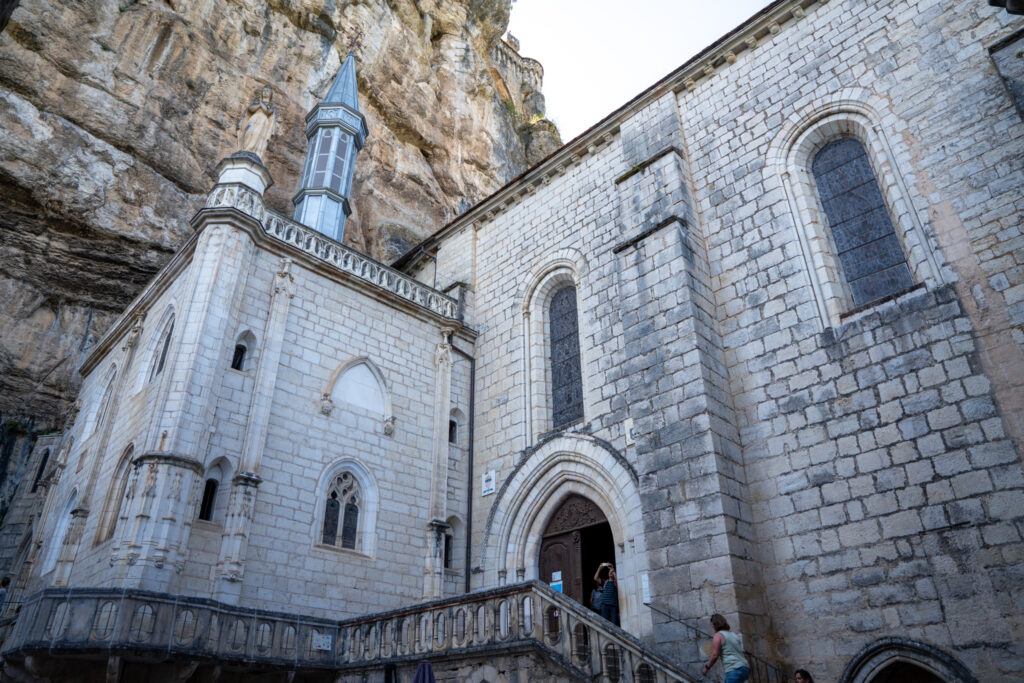
The UNESCO World Heritage Site is architecturally impressive, with hints of Romanesque and Gothic design. Ornate balconies and stained-glass windows sit beneath lookout towers and exterior walls etched with ancient inscriptions. And if you step inside, you’ll find the interior beautifully lit with vaulted ceilings, shrines, frescoes and statues.
Seek Miracles at Chapelle Notre-Dame
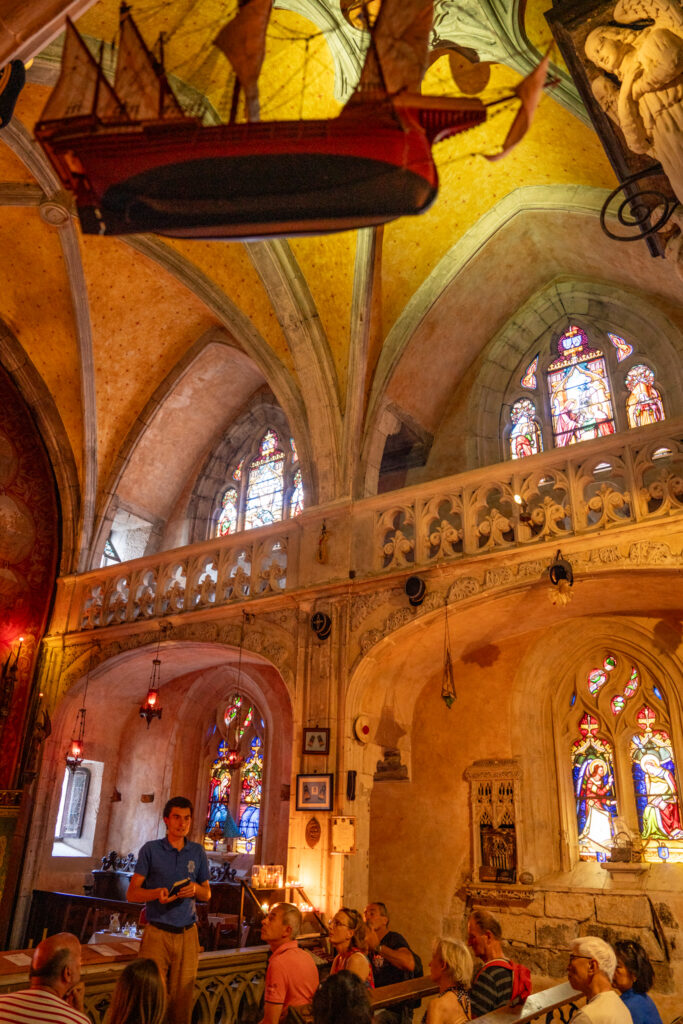

Next door to the Basilica, you’ll find Chapelle Notre-Dame, possibly the most famous in the complex. This chapel is home to the Black Madonna statue.
Following the discovery of the walnut-carved statue in the tomb of Saint Amadour, pilgrims began to flock to the city. According to the records of Benedictine monks, great miracles began to take place. Such miracles included the safe return of ships from perilous voyages, healing from ailments, curing infertility and more.
Some of the miracles are represented in the chapel by ship votives pinned to the walls, left as offerings to the Black Madonna. There’s also an iron bell suspended from the ceiling; said to toll every time a new miracle occurs.
The Durandel sword – which belonged to Charlemagne’s nephew – once sat above the chapel embedded in the rock face. It was whisked away here during battle for safekeeping, preventing it from falling into enemy hands, although as of recently, reports say that it has mysteriously disappeared…
See the Saint Amadour Crypt

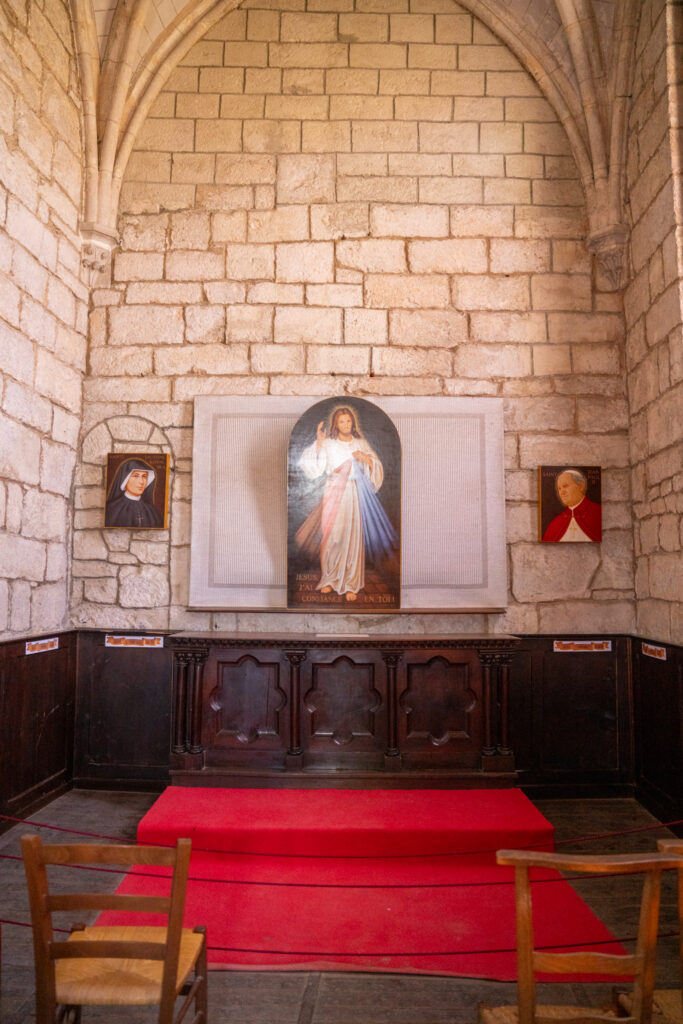
Another chapel to make time for during your Rocamadour visit is Chapelle Miraculeuse. This small and simple chapel contains the crypt of Saint Amadour.
As mentioned earlier, the perfectly preserved body of a man said to be St-Amadour was discovered in Rocamadour in the 1100s. The story states that he worked for the Holy Family, and when he married Saint Veronica, he moved with her to France to help spread the faith.

Although his original tomb was burned during the Wars of Religion, his remains were brought here to this peaceful chapel in the cliff face.
Inside the chapel, you’ll find a single nave with vaulted ceilings and columns created in a distinct Romanesque style. Pilgrims still arrive here today to pay homage to the saint that gave Rocamadour its name.
Savour Views from Chateau de Rocamadour

High upon the clifftop overlooking the village, you’ll find the imposing Rocamadour Castle. It was originally constructed in the 14th century to protect the sanctuary below, and originally designed with towers, lookout points and even a moat!
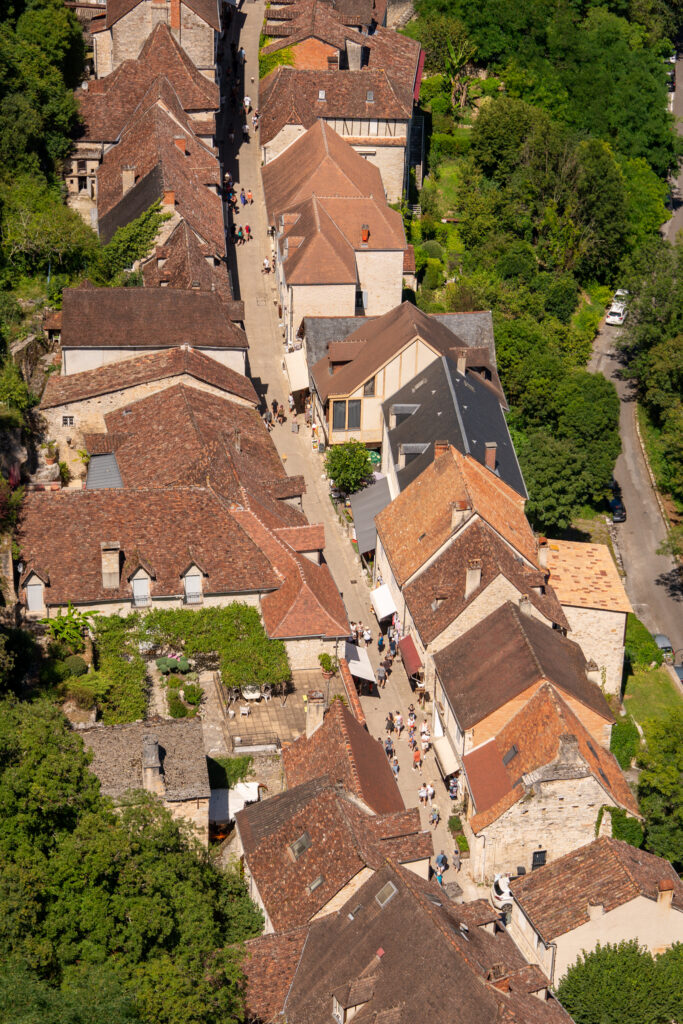

Although the interior is not open to visitors, the ramparts are accessible and you can walk the walls while taking in the views across the Alzou Valley and the chateau gardens.
There is a small fee payable for doing so (it was €2 when we visited), and the stairs are narrow and a bit wonky – not ideal for kids or if you suffer from vertigo!
Walk the Way of the Cross

Return from the castle on foot via the Way of the Cross. The pilgrim’s path begins at the iron cross on the hilltop, said to have been brought here from the Holy Land by pilgrims.
The woodland pathway transports you to the 14 Stations of the Cross, past shrines and spiritually significant sites. Each one depicts the last walk of Christ towards his crucifixion.

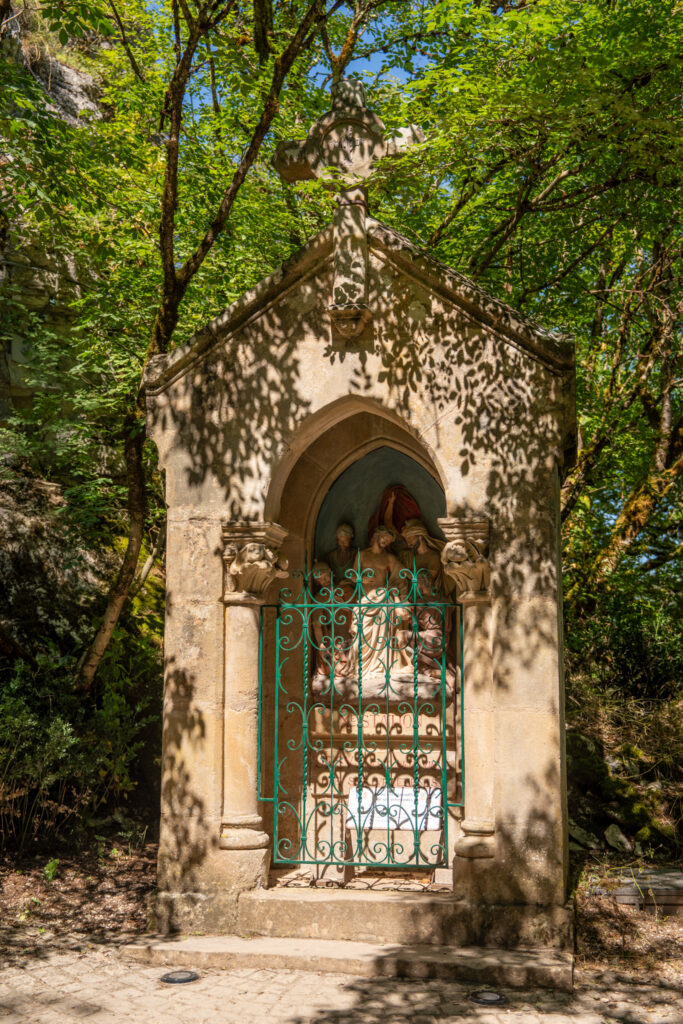
You can walk the route both ways, although this one is less strenuous leading back to the monastic complex. It’s a pretty pathway with lovely views and interesting relics to see along the route. And you’ll benefit from the shaded canopy the trees provide in summer!
Hike from Rocamadour Castle to L’Hospitalet
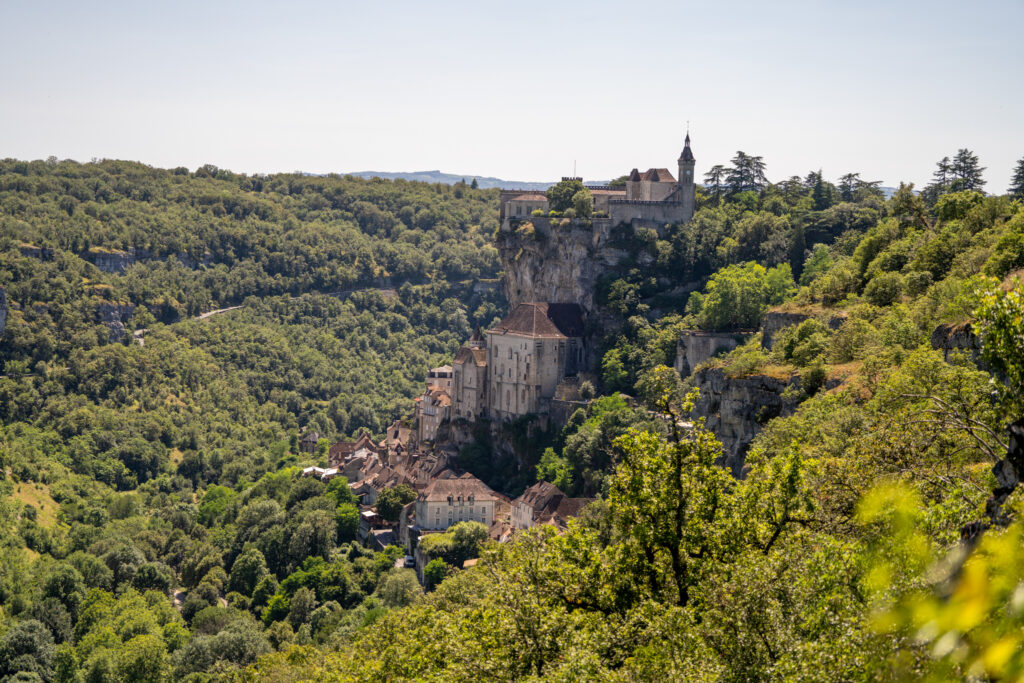
There are a handful of epic trails around Rocamadour, where you can immerse yourself in the wonders of nature for hours at a time. However, you can still appreciate some shorter walks if you don’t have hours to spare.
One to mention is a short 50-minute loop trail that you can take from Rocamadour Castle to L’Hospitalet and back through the village. The partially shaded trail is a fairly easy walk (except in the scorching August sun) and fun for all the family.
It passes by the entrance to the prehistoric Grotte Des Merveilles and there are several bars and restaurants for refreshments and snacks in the village along the way. Spoiler alert: this route also has the best views of Rocamadour, allowing for exceptional photo opportunities.
Or Hike from Rocamadour to Gramat

Alternatively, opt for a longer hike to the pretty market town of Gramat. This scenic route transports you through the Alzou Gorges, along the river, past old stone watermills and through ancient forests. Along the GR6 route, you’ll see the Saut Mill (including the interior and its workings), and medieval ruins, and wander through ancient forests.
Most of the trail follows the tree line of the forest, ideal for spending time in nature and tranquillity. However, the hike is quite long and not for the faint-hearted, taking around five hours there and back. You can, however, switch routes on your return journey and hike the orange trail for a change of scenery.
Step Back in Time at Grotte Des Merveilles
The Grotte Des Merveilles were discovered in 1920, although they date back much further to the Paleolithic era. In fact, the wall etchings of deer, big cats, hands and horses inside the caves are said to have been drawn around 20,000 years ago!
The incredible subterranean cave is accessed via steps leading to centuries-old rock formations, stalactites and even a lake.
You can take a guided tour (45 minutes to one hour long) to learn more about the caves’ history and geology, and afterwards, enjoy a picnic beneath the trees as the kids let off steam in the outside play park.
We opted not to visit the caves this time around, as we’d just been to the very impressive Gouffre de Padirac (more on that below).
Sample the Local Gastronomy

The local fare is relatively simple but there are a couple of gastronomic treats you should try if you’re in Rocamadour. The first is walnut bread. The entire Lot Valley and neighbouring Dordogne departments are famed for their premium quality walnuts which are served in bread, cakes, salads or simply eaten as they are.

Rocamadour is also known for its cheese which has been designated with the AOC mark of quality. Don’t forget to try the prized black truffles too. They are delicious shaved onto pasta and salads, and as a garnish for soups. If you have a sweet tooth, the local tarte tatin made with caramelised apples is always a winning dessert.
Arrive for the Hot Air Balloon Festival
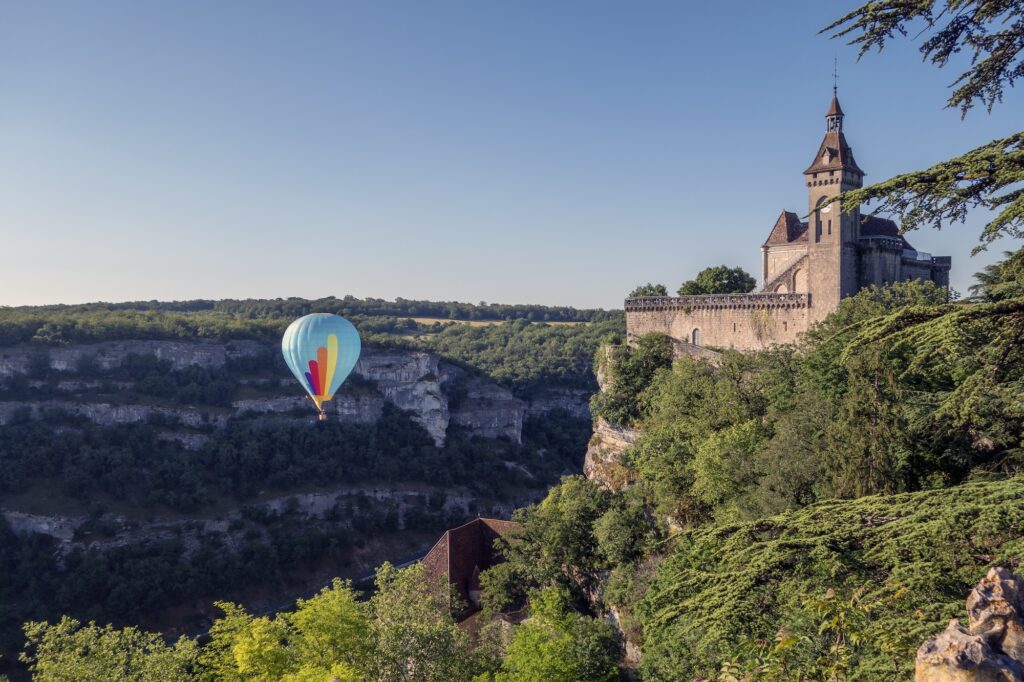
The Rocamadour Hot Air Balloon Festival takes place in late September each year. Thousands of spectators arrive to watch as dozens of balloons ascend to the skies from the depths of the Alzou Valley.
As they soar above the natural park, at sunrise and sunset, sip coffee or enjoy a meal on a terrace in the village or watch the spectacle from a hotel balcony with a glass of wine in hand.
You can end the day watching the spectacular fireworks display from a cosy spot (L’Hospitalet has great views) and photograph the sparkling lights framing the valley and picturesque village.
Other Things to do Around Rocamadour
If you’re spending an extended period in Rocamadour, or are staying nearby, there are plenty more things to do & see nearby. Here are a few of my favourites.
Gouffre de Padirac

Gouffre de Padirac is a remarkable underground cave system located just outside Rocamadour. You can travel deep below the surface of the earth to discover flowing subterranean rivers and lakes.
Explore the galleries and dome rooms expertly crafted by nature, guided by your audio in-ear device, before partaking in the highlight of the visit – a boat trip on a narrow river, 103m underground – where you’ll learn more about the caves from your gondolier.
The caves get very busy during the summer months, so book this activity in advance if travelling in July or August. There are plenty of nearby cafes and restaurants for a bite to eat, or a refreshing drink before or after your tour.
Read More: Unmissable Caves of the Dordogne and Lot
Castelnau-Bretenoux Castle

Experience life as royalty for the day at the Chateau de Castelnau-Bretenoux. This architectural masterpiece set in red stone has a history that spans several centuries. Throughout its existence, it has passed between the French and English before being purchased by a Parisian opera singer who bequeathed it to the state.
On a tour (guided tours are available year-round, whereas self-guided tours are only available during school holidays), you can admire the interior décor and learn all about the castle legends while taking in exquisite panoramic views from the hilltop.
Read More: Most Beautiful Castles in the Dordogne
Sarlat-la-Canéda

Sarlat-la-Canéda is a bit like a living history museum. This is a medieval town with winding cobbled streets and architecture that still looks polished even though it dates back centuries. You can spend a morning discussing the merits of walnuts and wine with vendors at open-air markets and pop into a grand chateau with manicured gardens in the afternoon.
This town is also a paradise for foodies with fine restaurants serving traditional fare of the Perigord Noir.
Read More: Most Beautiful Medieval Towns in France
La Forêt des Singes de Rocamadour

You’ll find La Forêt des Singes on the fringes of Rocamadour – a place where barbary macaques roam freely in idyllic forested spaces. Kids love learning about the monkey’s habits and watching them as they feed.
While you’re there, you can take part in feeding talks, discovery activities, education trails and fun games. So by the time you leave, you’ll know everything there is to know about these fascinating primates, and what the park is doing to help protect their species.
If history, architecture, food, nature and photography are high on your Lot Valley wish list, you’ll adore Rocamadour. This small, yet perfectly formed village etched into the cliff face, may be reminiscent of the fictional kingdom of Rivendell from Lord of the Rings, but it has an endearing charm all of its own that will keep both young and old captivated.




